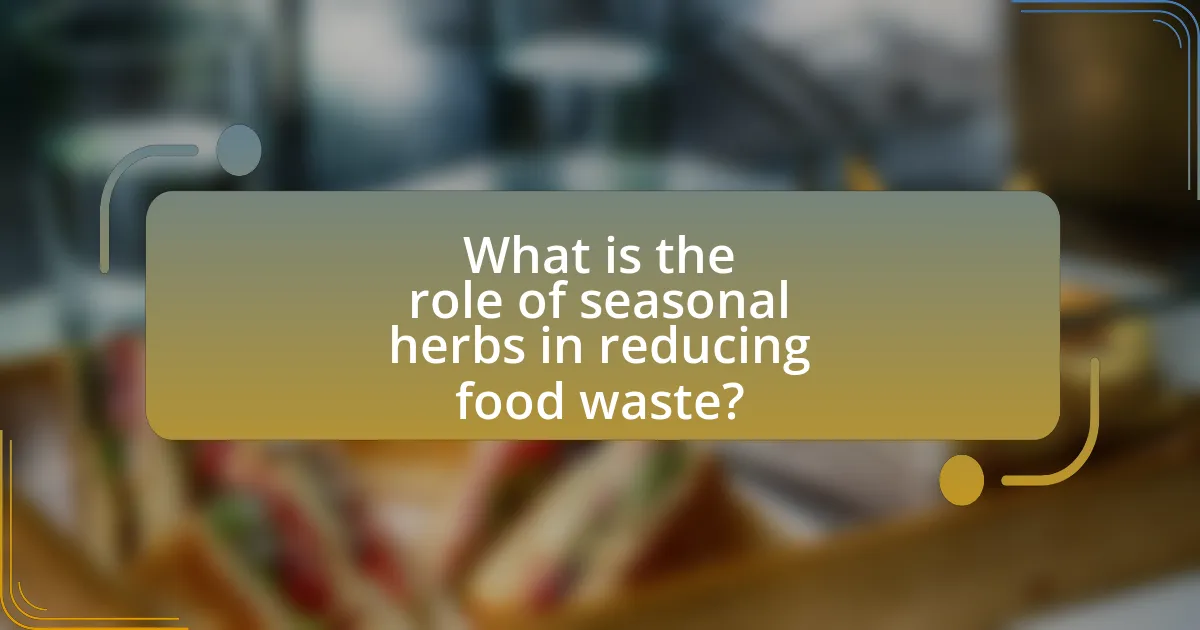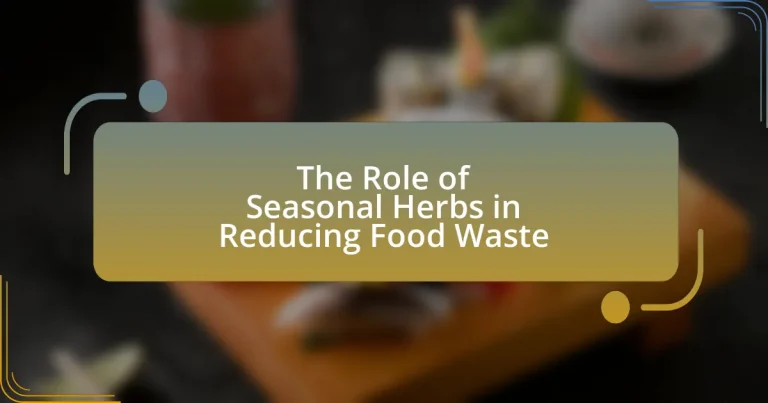Seasonal herbs play a crucial role in reducing food waste by enhancing the flavor and preservation of perishable foods, encouraging their consumption. These herbs possess antimicrobial, antioxidant, and antifungal properties that help extend the shelf life of ingredients, making them more palatable and less likely to be discarded. Utilizing seasonal herbs aligns with local agricultural practices, promoting the use of fresh ingredients and minimizing waste associated with long supply chains. The article explores the specific properties of seasonal herbs, their impact on food preservation, and practical tips for incorporating them into meals to effectively reduce food waste. Additionally, it highlights the environmental and economic implications of food waste, emphasizing the importance of sustainable practices in cooking.

What is the role of seasonal herbs in reducing food waste?
Seasonal herbs play a significant role in reducing food waste by enhancing the flavor and preservation of perishable foods, thereby encouraging their consumption. When used in cooking, these herbs can make less desirable or nearing spoilage ingredients more palatable, leading to their utilization rather than disposal. For instance, studies have shown that incorporating herbs like basil or cilantro can extend the shelf life of dishes by providing antimicrobial properties, which helps prevent spoilage. Additionally, using seasonal herbs aligns with local agricultural practices, promoting the use of fresh, readily available ingredients, which reduces the likelihood of waste associated with long supply chains and overproduction.
How do seasonal herbs contribute to minimizing food waste?
Seasonal herbs contribute to minimizing food waste by enhancing the flavor and preservation of dishes, encouraging the use of fresh ingredients before they spoil. When seasonal herbs are incorporated into meals, they can elevate the taste, making it more appealing and reducing the likelihood of leftovers being discarded. Additionally, using herbs that are in season aligns with local agricultural cycles, promoting the consumption of produce that is fresher and more abundant, which in turn decreases the chances of spoilage. Research indicates that utilizing seasonal ingredients can lead to a 30% reduction in food waste, as highlighted in studies by the Food and Agriculture Organization, which emphasize the importance of local sourcing and seasonal consumption in waste reduction strategies.
What specific properties of seasonal herbs help in food preservation?
Seasonal herbs possess antimicrobial, antioxidant, and antifungal properties that significantly aid in food preservation. These properties help inhibit the growth of spoilage-causing microorganisms, thereby extending the shelf life of food. For instance, compounds such as thymol in thyme and rosmarinic acid in rosemary have been shown to effectively reduce bacterial load in food products, as evidenced by studies demonstrating their efficacy against pathogens like E. coli and Salmonella. Additionally, the high antioxidant content in herbs like oregano and basil helps prevent oxidative degradation of food, further contributing to preservation.
How do seasonal herbs enhance the shelf life of perishable foods?
Seasonal herbs enhance the shelf life of perishable foods primarily through their natural antimicrobial properties. These herbs contain essential oils and compounds, such as thymol in thyme and eugenol in basil, which inhibit the growth of bacteria and fungi that cause spoilage. Research has shown that incorporating herbs like rosemary and oregano into food can significantly reduce microbial load, thereby extending freshness. For instance, a study published in the Journal of Food Science demonstrated that rosemary extract effectively increased the shelf life of meat products by 30% due to its antioxidant and antimicrobial effects.
Why is food waste a significant issue in today’s society?
Food waste is a significant issue in today’s society because it contributes to environmental degradation, economic loss, and social inequality. Approximately one-third of all food produced globally, amounting to about 1.3 billion tons annually, is wasted, leading to the unnecessary use of resources such as water, land, and energy. This waste generates about 8-10% of global greenhouse gas emissions, exacerbating climate change. Economically, food waste costs the global economy around $940 billion each year, impacting farmers, businesses, and consumers alike. Socially, food waste occurs alongside food insecurity, with nearly 690 million people going hungry while vast amounts of food are discarded. These factors highlight the urgency of addressing food waste as a critical issue in contemporary society.
What are the environmental impacts of food waste?
Food waste has significant environmental impacts, primarily contributing to greenhouse gas emissions, resource depletion, and biodiversity loss. When food is discarded, it often ends up in landfills, where it decomposes anaerobically, producing methane, a potent greenhouse gas that is over 25 times more effective at trapping heat in the atmosphere than carbon dioxide over a 100-year period. According to the Food and Agriculture Organization (FAO), approximately 1.3 billion tons of food waste are generated globally each year, accounting for about 8-10% of total greenhouse gas emissions. Additionally, food production consumes vast amounts of water and land; wasting food means wasting the resources used to produce it. For instance, it takes about 1,800 gallons of water to produce just one pound of beef, highlighting the extensive water footprint associated with food waste. Furthermore, food waste contributes to biodiversity loss as agricultural expansion often leads to habitat destruction. Thus, reducing food waste is crucial for mitigating these environmental impacts.
How does food waste affect economic stability?
Food waste negatively impacts economic stability by contributing to financial losses for businesses and increasing costs for consumers. In the United States, approximately 30-40% of the food supply is wasted, which translates to an estimated $161 billion annually in lost revenue. This waste not only affects producers and retailers but also strains municipal waste management systems, leading to higher disposal costs. Additionally, food waste exacerbates food insecurity, as resources that could have been used to feed those in need are instead discarded, further destabilizing local economies.
What are the benefits of using seasonal herbs in cooking?
Using seasonal herbs in cooking enhances flavor, nutrition, and sustainability. Seasonal herbs are fresher and more flavorful, as they are harvested at their peak, which improves the overall taste of dishes. Additionally, these herbs often contain higher levels of essential nutrients and antioxidants compared to out-of-season varieties, contributing to healthier meals. Furthermore, utilizing seasonal herbs supports local agriculture and reduces food waste, as they are more readily available and less likely to spoil during transport. This practice aligns with sustainable cooking principles, promoting environmental responsibility while maximizing culinary enjoyment.
How do seasonal herbs improve flavor and nutrition in meals?
Seasonal herbs enhance flavor and nutrition in meals by providing fresh, vibrant tastes and concentrated nutrients that are often more potent than dried alternatives. Fresh herbs like basil, cilantro, and parsley contain essential vitamins, minerals, and antioxidants, which contribute to overall health. For example, basil is rich in vitamin K and has anti-inflammatory properties, while cilantro is known for its detoxifying effects. The use of seasonal herbs not only elevates the sensory experience of dishes but also encourages the consumption of nutrient-dense ingredients, thereby promoting healthier eating habits. Studies have shown that incorporating fresh herbs can significantly increase the antioxidant capacity of meals, making them more beneficial for health.
What are the cost benefits of incorporating seasonal herbs into diets?
Incorporating seasonal herbs into diets offers significant cost benefits by reducing grocery expenses and minimizing food waste. Seasonal herbs are typically less expensive due to their abundance and lower transportation costs, as they are harvested at their peak. For example, using locally sourced seasonal herbs can save consumers up to 30% compared to purchasing out-of-season or imported herbs. Additionally, these herbs enhance the flavor of dishes, allowing for smaller quantities of more expensive ingredients to be used, further reducing overall food costs. By integrating seasonal herbs, households can optimize their budgets while promoting sustainable eating practices that contribute to reduced food waste.
How can seasonal herbs be effectively utilized to reduce food waste?
Seasonal herbs can be effectively utilized to reduce food waste by enhancing the flavor and preservation of perishable foods. By incorporating seasonal herbs into dishes, individuals can make less desirable or nearing spoilage ingredients more palatable, encouraging their consumption rather than disposal. For instance, studies show that herbs like basil and cilantro not only add taste but also possess antimicrobial properties that can extend the shelf life of certain foods. Additionally, using herbs in marinades or dressings can help mask the flavors of ingredients that are past their prime, thus reducing the likelihood of food waste.
What are the best practices for storing seasonal herbs?
The best practices for storing seasonal herbs include keeping them dry, using airtight containers, and refrigerating or freezing them for long-term storage. Drying herbs prevents mold and decay, while airtight containers protect against moisture and air exposure, which can degrade flavor and potency. Refrigeration is effective for short-term storage, especially for fresh herbs like basil and cilantro, while freezing is ideal for preserving herbs like parsley and dill for extended periods. Studies show that proper storage can extend the shelf life of herbs significantly, reducing food waste and maintaining their culinary value.
How can proper storage extend the life of seasonal herbs?
Proper storage can significantly extend the life of seasonal herbs by maintaining their freshness and preventing spoilage. When herbs are stored in a cool, dry place or refrigerated in airtight containers, they are protected from moisture and air exposure, which can lead to wilting and decay. For example, studies show that storing herbs like basil upright in water or wrapping them in a damp paper towel and placing them in a plastic bag can keep them fresh for up to two weeks longer than if left at room temperature. This effective storage method not only preserves the herbs’ flavor and nutritional value but also contributes to reducing food waste by allowing consumers to use herbs over an extended period.
What techniques can be used to preserve seasonal herbs for later use?
Techniques to preserve seasonal herbs for later use include drying, freezing, and making herb-infused oils or vinegars. Drying involves removing moisture from the herbs, which can be done using air drying, oven drying, or dehydrators, effectively extending their shelf life by preventing mold growth. Freezing preserves the flavor and nutrients of herbs; this can be done by chopping the herbs and placing them in ice cube trays with water or oil, allowing for easy portioning later. Additionally, creating herb-infused oils or vinegars captures the essence of the herbs and can be stored for several months, providing a flavorful addition to dishes. These methods are widely recognized for their effectiveness in maintaining the quality and usability of herbs beyond their growing season.
What are some common seasonal herbs and their uses?
Common seasonal herbs include basil, cilantro, dill, and thyme, each with distinct culinary uses. Basil is often used in Italian dishes, particularly in sauces and salads, while cilantro is prevalent in Mexican and Asian cuisines, enhancing salsas and curries. Dill is commonly used in pickling and pairs well with fish, and thyme is versatile, used in soups, stews, and roasted dishes. These herbs not only add flavor but also help reduce food waste by enhancing the taste of leftover ingredients, encouraging their use in meals.
Which seasonal herbs are most effective in reducing food waste?
Seasonal herbs such as basil, cilantro, and parsley are most effective in reducing food waste. These herbs enhance the flavor of dishes, encouraging the use of leftover ingredients and minimizing spoilage. For instance, basil can be used in various recipes, including sauces and salads, which helps utilize excess vegetables. Additionally, cilantro and parsley can be added to dishes to elevate taste, promoting the consumption of ingredients that might otherwise be discarded. Studies indicate that incorporating herbs into meals can lead to a 30% reduction in food waste by making leftovers more appealing.
How can different seasonal herbs be paired with various foods?
Different seasonal herbs can be paired with various foods by matching their flavor profiles to enhance dishes. For example, basil complements tomatoes and mozzarella in Caprese salad, while rosemary pairs well with roasted meats and potatoes. Seasonal herbs like cilantro enhance the freshness of salsas and Asian dishes, while thyme works effectively with poultry and vegetables. These pairings not only elevate the taste but also encourage the use of fresh, seasonal ingredients, thereby reducing food waste by promoting the consumption of locally available produce.
What practical tips can help individuals reduce food waste using seasonal herbs?
To reduce food waste using seasonal herbs, individuals can implement several practical tips. First, they should incorporate herbs into various dishes to enhance flavor and minimize leftover ingredients; for example, using basil in pasta or cilantro in tacos can encourage the use of other perishable items. Second, individuals can grow their own herbs, which allows for fresh access and reduces the likelihood of purchasing excess that may spoil. Third, they can preserve seasonal herbs by drying or freezing them, extending their shelf life and usability in future meals. Lastly, individuals can plan meals around seasonal herbs, ensuring that they utilize them while fresh and reducing the chance of waste. These strategies not only promote the use of seasonal herbs but also contribute to overall food waste reduction.


